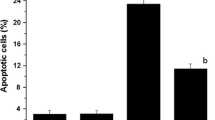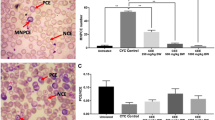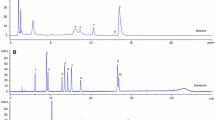Abstract
The aim of the present investigation is to determine whether the caffeic acid phenethyl ester (CAPE) in combination with mitomycine-C (MMC) can ameliorate MMC-induced clastogenesis in the bone marrow cells of mice. The scoring of chromosomal aberrations, mitotic activity and micronuclei were undertaken in the current study as markers of clastogenicity. The action of CAPE in adenosine deaminase enzyme (ADA) activities of serum, thymus and spleen were also investigated. The animals were orally administered CAPE alone at the doses 5 or 10 mg kg b.wt.-1 for 5 days then sacrificed 24 hours after the CAPE administration. MMC was administered to mice either alone at a single dose (2 mg kg b.wt.-1) by intraperitoneal injection, before or after CAPE treatment. Pre or post – treatment with two doses of CAPE significantly decreased the number of chromosomal aberrations, micronuclei and adapted the mitotic activity reduction in the bone marrow cells of mice induced by MMC when compared with only MMC given group. In addition, combination treatment with MMC caused a significant decrease in the activities of ADA in serum, thymus and spleen. The results of this study showed that ADA activity probably related to high levels of reactive oxygen species. This study concluded that the protective effect of CAPE against MMC clastogenesis resides at least in part, in its antioxidant effects.


Similar content being viewed by others
References
Aldrich MB, Blackburn MR, Kellems RE (2000) The importance of adenosine deaminase for lymphocyte development and function. Biochem Biophys Res Comm 272:311–315
Ames BN (1983) Dietary carcinogens and anticarcinogens: oxygen radicals and degenerative diseases. Science 221:1256–1264
Borrelli F, Izzo AA, Di Carlo G, Maffia P, Russo A, Maiello FM, Capasso F, Mascolo N (2002) Effect of a propolis extract and caffeic acid phenethyl ester on formation of aberrant crypt foci and tumors in the rat colon. Fitoterapia 73:38–43
Brookes P (1990) The early history of the biological alkylating agents, 1918-1968. Mutat Res 233:3–14
Chiao C, Carothers AM, Grunberger D, Solomon G, Preston GA, Barrett JC (1995) Apoptosis and altered redox state induced by caffeic acid phenethyl ester (CAPE) in transformed rat fibroblast cells. Cancer Res 55:3576–3583
Conklin KA (2004) Cancer chemotherapy and antioxidants. J Nutr 134:3201–3204
DeMas P, Daudin M, Vincent MC, Bourrouillou G, Calvas P, Mieusset R, Bujan L (2001) Increased aneuploidy in spermatozoa from testicular tumour patients after chemotherapy with cisplatin, etoposide and bleomycin. Hum Reprod 16:1204–1208
Elsendoorn TJ, Weijl NI, Mithoe S, Zwinderman AH, Van Dam F, De Zwart FA, Tates AD, Osanto S (2001) Chemotherapy-induced chromosomal damage in peripheral blood lymphocytes of cancer patients supplemented with antioxidants or placebo. Mutat Res 498:145–158
Fadillioglu E, Yilmaz HR, Erdogan H, Sogut S (2003) The activities of tissue xanthine oxidase and adenosine deaminase and the levels of hydroxyproline and nitric oxide in rat hearts subjected to doxorubicin: protective effect of erdosteine. Toxicology 191:153–158
Feig OI, Reid TM, Loeb LA (1994) Reactive oxygen species in tumorigenesis. Cancer Res 54:1890–1894
Fritsche M, Haessler C, Brandner G (1993) Induction of nuclear accumulation of the turnersuppressor protein p53 by DNA damaging agents. Oncogene 8:307–318
Giusti G (1981) Adenosine Deaminase. In: Bergmeyer HU (ed) Methods of Enzymatic Analysis, vol 2, 2nd edn. Academic, New York, pp 1092–1099
Korkina LG, Deeva IB, Biase AD, Iaccarino M, Oral R, Warnau M, Pagano G (2000) Redox dependent toxicity of diepoxybutane and mitomycin C in sea urchin embrogenesis. Carcinogenesis 21:2213–2220
Lamson DW, Brignall MS (2000) Antioxidants and cancer, part 3: quercetin. Altern Med Rev 5:196–208
Lee YJ, Park SJ, Ciccone SLM, Kim CR, Lee SH (2006) An in vivo analysis of MMC-induced DNA damage and its repair. Carcinogenesis 27:446–453
Liesveld JL, Abbound CN, Lu C, McNair C, Menon A, Smith A, Rosell K, Rapoport AP (2003) Flavonoid effect on normal and leukemic cells. Leuk Res 27:517–527
Lowry OH, Rosenbrough NJ, Farr AL, Randall RJ (1951) Protein measurement with the Folin phenol reagent. J Biol Chem 193:265–275
Madrigal-Bujaidar E, Diaz Barriga S, Cassani M, Marquez P, Revuelta P (1998) In vivo and in vitro antigenotoxic effect of nordihydroguaiaretic acid against SCEs induced by methyl methanesulfonate. Mut Res 419:163–168
Mazumdar M, Girl S, Singh S, Kausar A, Giri A, Sharma GD (2011) Antioxidative potential of vitamin c against chemotherapeutic agent Mitomycin C induced genotoxicity in somatic and germ cells in mouse test model. Assam Univ J Sci Technol 7:10–17
Minford J, Pommier Y, Filipski J, Kohn KW, Kerrigan D, Mattern M, Michaels S, Schwartz R, Zwelling LA (1986) Isolation of intercalator-dependent protein-linked DNA strand cleavage activity from cell nuclei and identification as topoisomerase II. Biochemistry 25:9–16
Oktem F, Yilmaz HR, Ozguner F, Olgar S, Ayata A, Uzare E, Uz E (2006) Methotrexate-induced renal oxidative stress in rats: the role of a novel antioxidant caffeic acid phenethyl ester. Toxicol Ind Health 22:241–247
Orban Z, Mitsiades N, Burke TR, Tsokos M, Chrousos GP (2000) Caffeic acid phenethyl ester induces leukocyte apoptosis, modulates nuclear factor-kappa B and suppress acute inflammation. Neuroimmunomodulation 7:99–105
Osanto S, Thijssen JC, Woldering VM, van Rijn JL, Natarajan AT, Tates AD (1991) Increased frequency of chromosomal damage in peripheral blood lymphocytes up to 9 years following curative chemotherapy of patients with testicular carcinoma. Environ Mol Mutagen 17:71–78
Ozen S, Akyol O, Iraz M, Sogut S, Ozugurlu F, Ozyurt H, Odaci E, Yildirim Z (2004) Role of caffeic acid phenethyl ester, an active component of propolis, against cisplatin-induced nephrotoxicity in rats. J Appl Toxicol 24:27–35
Park JH, Lee JK, Kim HS, Chung ST, Eom JH, Kim KA, Chung SJ, Paik SY, Oh HY (2004) Immunomodulatory effect of caffeic acid phenethyl ester in Balb/c mice. Int Immunopharmacol 4:429–436
Paz MM, Kumar GS, Glover M, Waring MJ, Tomasz M (2004) Mitomycin dimers: polyfunctional cross-linkers of DNA. J Med Chem 47:3308–3319
Piantelli M, Rossi C, Iezzi M, La Sorda R, Iacobelli S, Alberti S, Natali PG (2006) Flavonoids inhibit melanoma lung metastasis by impairing tumor cells endothelium interactions. J Cell Physiol 207:23–39
Resta R, Hooker SW, Laurent AB, Rahman J, Franklin M, Knudsen TB, Nadon NL, Thompson LF (1997) Insights into thymic purine metabolism and adenosine deaminase deficiency revealed by transgenic mice overexpressing ecto- 5- nucleotidase (CD 73). J Clin Invest 99:676–683
Rubbo H, O’Donnell V (2005) Nitric oxide, peroxynitrite and lipoxygenase in atherogenesis: mechanistic insights. Toxicology 208:305–317
Russo A, Stocco A, Renzi L, Bianco N, Majone F (1992) Persistence of chromosomal lesions induced in actively proliferating bone marrow cells of the mouse. Mutat Res 269:119–127
Russo A, Longo R, Vanella A (2002) Antioxidant activity of propolis: role of caffeic acid phenethyl ester and galangin. Fitoterapia 73:S21–S29
Scarpato R, Migliore L (1996) Comparison of spontaneous structural chromosome aberration frequency in 48 h-cultured human lymphocytes mitotically arrested by different colchemid treatments. Mutat Res 361:35–39
Sontakke YA, Fulzele RR (2009) Cytogenetic study on genotoxicity of antitumor-antibiotic Mitomycin C. Biomed Res 20:40–44
Sulaiman GM, Al Sammarrae KW, Ad'hiah AH, Zucchetti M, Frapolli R, Bello E, Erba E, D'Incalci M, Bagnati R (2011) Chemical characterization of Iraqi propolis samples and assessing their antioxidant potentials. Food Chem Toxicol 49:2415–2421
Uz E, Oktem F, Yilmaz HR, Uzar E, Ozguner F (2005) The activities of purine-catabolizing enzymes and the level of nitric oxide in rat kidneys subjected to methotrexate: protective effect of caffeic acid phenethyl ester. Mol Cell Biochem 277:165–170
Uzar E, Sahin O, Koyuncuoglu HR, Uz E, Bas O, Kilbas S, Yilmaz HR, Yurekli VA, Kucuker H, Songur A (2006) The activity of adenosine deaminase and the level of nitric oxide in spinal cord of methotrexate administered rats: protective effect of caffeic acid phenethyl ester. Toxicology 218:125–133
Warren AJ, Mustra DJ, Hamilton JW (2001) Detection of Mitomycin C-DNA adducts in human breast cancer cells grown in culture, as xenografted tumors in nude mice, and in biopsies of human breast cancer patient tumors as determined by 32P-Postlabeling. Clin Cancer Res 7:1033–1042
Yagmurca M, Erdogan H, Iraz M, Songur A, Ucar M, Fadillioglu E (2004) Caffeic acid phenethyl ester as a protective agent against doxorubicin nephrotoxicity in rats. Clin Chem Acta 348:27–34
Yildiz OG, Soyuer S, Saraymen R, Eroglu C (2008) Protective effects of caffeic acid phenethyl ester on radiation induced lung injury in rats. Clin Invest Med 31:242–247
Yilmaz HR, Uz E, Yucel N, Altuntas I, Ozcelik N (2004) Protective effect of caffeic acid phenethyl ester (CAPE) on lipid peroxidation and antioxidant enzymes in diabetic rat liver. J Biochem Mol Toxicol 18:234–238
Yilmaz HR, Sogut S, Ozyurt B, Ozugurlu F, Sahin S, Isik B, Uz E, Ozyurt H (2005) The activities of liver adenosine deaminase, xanthine oxidase, catalase, superoxide dismutase enzymes and the levels of malondialdehyde and nitric oxide after cisplatin toxicity in rats: protective effect of caffeic acid phenethyl ester. Toxicol Ind Health 21:67–73
Yilmaz HR, Uz E, Altunbasak A, Sakalli E, Ozçelik N (2010) Anticlastogenic effect of caffeic acid phenethyl ester on cisplatin-induced chromosome aberrations in rat bone marrow cells. Toxicol Ind Health 26:33–37
Acknowledgements
The author is grateful to Dr. Farooq Mohammad Ibrahim for assistance with certain techniques.
Conflict of interest statement
None declared.
Author information
Authors and Affiliations
Corresponding author
Rights and permissions
About this article
Cite this article
Sulaiman, G.M. Role of caffeic acid phenethyl ester on mitomycin C induced clastogenesis: analysis of chromosome aberrations, micronucleus, mitotic index and adenosine deaminase activity in vivo . J Appl Genetics 53, 213–219 (2012). https://doi.org/10.1007/s13353-012-0089-x
Received:
Revised:
Accepted:
Published:
Issue Date:
DOI: https://doi.org/10.1007/s13353-012-0089-x




